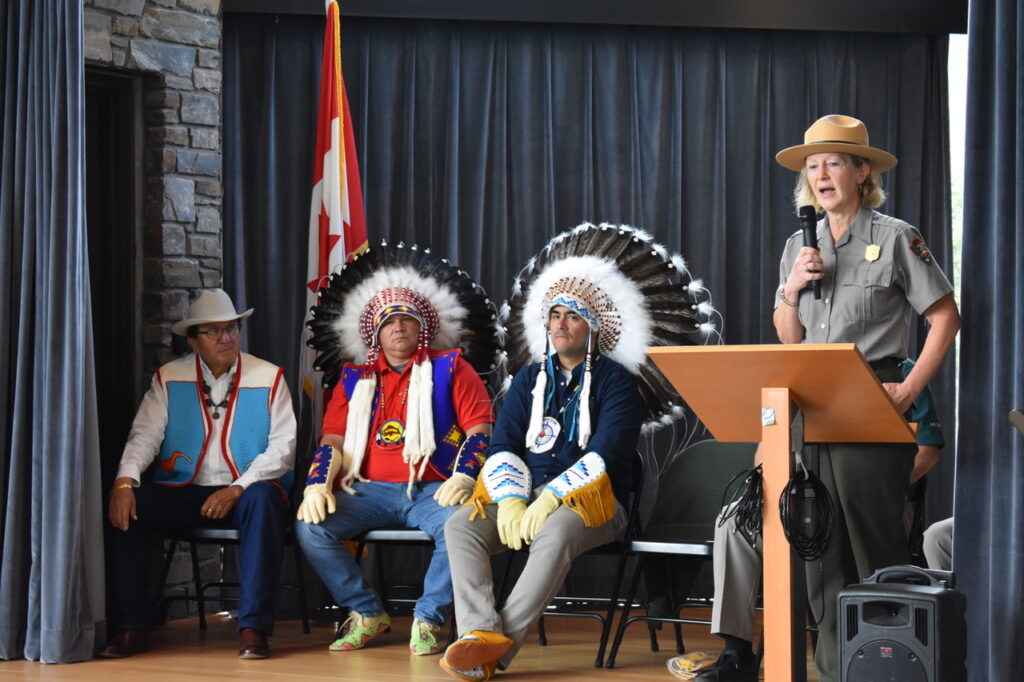CHIEF MOUNTAIN BORDER CROSSING— When two bison belonging to the Blackfeet Nation of Montana attempted to enter Canada in September, rangers from Parks Canada, the country’s national park agency, met them before they could cross the border and gently steered them home.
It’s not that American bison, or buffalo, haven’t been welcome in Canada. When bison were on the brink of extinction in 1907, the Canadian government moved nearly 700 of them by train from Montana’s Flathead Valley to Alberta to ensure the keystone species’ survival. The Canadian program was so successful that the animals had to be moved again, to what is now Elk Island National Park. There, for more than 80 years, genetically pure stock has served as the base for an ambitious program reintroducing bison across Canada, into the United States, and around the world.
It’s from this herd that the Blackfeet Nation — part of the four-nation, boundary-spanning Blackfoot Confederacy — reintroduced 87 bison onto their land in Montana in 2016 with the help of wardens and biologists from Parks Canada. In summer 2023 the Blackfeet released 49 of these bison within a large section of the Blackfeet Tribal lands adjacent to the Waterton-Glacier International Peace Park and the Canada-U.S. Border.

And it’s from this land that bison keep finding their way into Waterton Lakes or Glacier National Park or up to the border — indifferent to political lines and simply roaming through their territory, as their ancestors did for centuries.
That territory, of course, has since been carved up into parcels now owned by different countries, public-land management agencies, and private entities, as well as Tribes.
Bison roaming freely presents challenges and potential threats to the massive animals, not the least of which is international bureaucracy. Every stray wandering near the border requires the cooperation of 20 government agencies, including the Blackfeet Tribal Business Council and Alberta government, as well as the blessing of private landowners to turn them homeward.
“There’s a cultural connection to returning the buffalo back to the Blackfeet from Elk Island,” says Troy Heinert, executive director of the Intertribal Buffalo Council, based in Montana. “The Tribes that have sister Tribes or a presence on both sides of the border… it’s a little easier for them to work with international agencies in their buffalo program. But the paperwork is not very easy when you’re transporting buffalo across international borders.”

Bison reintroduction programs have gained traction on Tribal lands in the United States and Canada in recent years amid growing understanding of their role in ecosystem management and the impact their eradication has had on First Nations and Indigenous people. The overarching initiative — often requiring vast interagency cooperation — shows no signs of slowing despite its challenges.
The Canadian government views the bison program as part of its fundamental responsibility to address past harms against its First Nations.
“With our truth and reconciliation objectives within the government of Canada, rematriating bison to First Nations and Indigenous peoples is one of our first priorities,” says Brad Romaniuk, Parks Canada’s resource conservation manager, who oversees wildlife transfers and is part of the team that helps turn wandering bison back from the border. Rematriation, he explains, is an overarching initiative to restore the relationship between Indigenous peoples and their ancestral lands that takes many forms, including the return of bison. “If a [Tribal] nation approaches us and they have the facilities and we can help them get set up, they’re the first ones to get buffalo from us.”
In September the U.S. Department of the Interior also reaffirmed its commitment to herd reintroduction, allotting $5 million to the restoration of bison and grassland ecosystems in Tribal communities.
“The American bison is inextricably intertwined with Indigenous culture, grassland ecology and American history,” Interior Secretary Deb Haaland wrote in a statement. “While the overall recovery of bison over the last 130 years is a conservation success story, significant work remains to not only ensure that bison will remain a viable species but also to restore grassland ecosystems, strengthen rural economies dependent on grassland health and provide for the return of bison to Tribally owned and ancestral lands.”
There are more than 80 Tribes in the buffalo council across 32 million acres of lands, managing 30,000 animals. Heinert says he receives calls from newly engaged Tribes nearly every day requesting information on joining the program. While some, like the Blackfeet, will receive herds from Elk Island, ultimately the source of each herd will depend on the reason for the request: whether bison are to be used to heal the land, reestablish a cultural and spiritual connection, restore a food source, or something else.

“Wind Cave, Yellowstone, Grand Canyon, Badlands, those other national parks and grasslands that we take surplus buffalo from, it really comes to the intended purpose for that Tribe,” Heinert says. “Some Tribes are looking for specific genetics. Some Tribes are looking for genetic diversity, so maybe they have received Badlands buffalo for years and now they want to bring some Teddy Roosevelt in.”
Reintroducing a herd isn’t simply a matter of releasing it into a new location. The buffalo council provides technical services, training in management techniques and herd health, support with herd development grants and other financial resources, trainings for bison workers or herd managers, and more. In addition to providing the bison, Parks Canada helps with transport, collaring, and other services.
“Some of the challenges are obviously making sure Tribes are prepared to manage buffalo,” Heinert says. “We have Tribes that have managed buffalo for decades and Tribes that are brand new, so making sure they have the infrastructure and the right numbers on the landscape that they have dedicated to their buffalo program… that all takes resources, and Tribes very seldom have extra resources to dedicate to their buffalo program.”
It’s all “so much more than just backing up a trailer and opening a gate,” Heinert says. “In some cases there’s years of preparation before the first buffalo is ever unloaded.”
View this post on Instagram
Ensuring the bison live where they’re meant to once they’ve been reintroduced is another difficult task. Some, like the ones Romaniuk and his team encountered in the fall, can be turned back before crossing international lines. Others, such as a cow and calf who made it across the border on Sept. 29, have to be rounded up and sent back. Leaving them to roam could jeopardize their survival.
The threat doesn’t come from Canadian government agencies. It doesn’t come from the U.S. government, either, which named the bison the “national mammal” in 2016, or the National Park Service, which claims it’s an “honor” to support the Blackfeet Nation in “their historic achievement.”
Rather, the potential threat lies on privately held ranches and other lands outside the parks.
“Our respect for our neighbors and stakeholders outside the park, where there’s no real social acceptance for the bison, is a concern for us,” Romaniuk says. “They’re welcome into Waterton Lakes, but where they’re not welcome currently is on the private lands to the east of us,” where they could eat food intended for livestock or knock down fences. “Don’t get me wrong, there are landowners adjacent to tribal lands that are supportive, but the ranching industry, some of them just can’t afford to have bison on their lands because of fences and feed.”
When asked about turning herds away, Naaman Horn — a public affairs specialist with the Intermountain Regional Office in Denver — sent a statement that read in part, “The park looks forward to working on a co-stewardship agreement with the Blackfeet to coordinate bison conservation and management in the Chief Mountain area. In the event this herd enters Glacier National Park, ensuring the safety of our visitors as well as the bison is our top priority. As a free-ranging herd, these bison will be treated as any other wildlife in the park and be allowed to roam freely on the landscape.”
Both governments stress that their role is simply to support the Tribes. All officials interviewed were careful not to take any credit for the initiatives, or even to propose a five- or 10-year plan, which they say is entirely Tribal-led. It’s a sentiment Heinert shares on behalf of the buffalo council, which he says is following the Tribes’ leads, even as he is often a driving force, quite literally, behind some of these reintroductions.
“I’ve been fortunate enough to drive a lot of those trucks delivering buffalo,” Heinert says. “When we show up to a Tribe, especially when it’s a Tribe that’s getting buffalo for the first time in maybe ever, knowing that when you see those Tribal members, knowing that the elders have never known buffalo on their lands, and the kids that are there, knowing that there will always be buffalo on their lands from that point forward, that to me is a reconnection and a reestablishment of that relationship that Indigenous people have had with buffalo.
“A lot of times it’s about healing and reconnecting to a life way that was a good way for many Tribes for a long time,” says Heinert. “We’ve seen the devastation with the decimation of the buffalo. A lot of Tribes view this as a way back to that lifestyle.”
![]()


